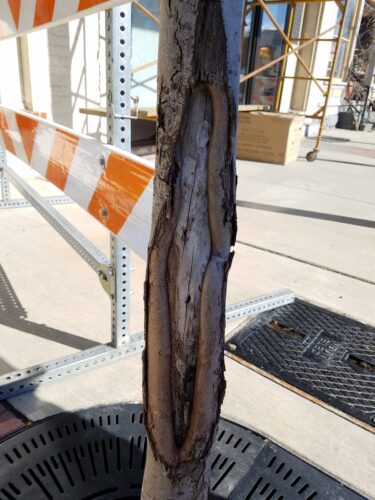
What is Wrong with My Tree?
Many different abiotic and biotic factors can affect the health of individual trees and planted and natural stands. Our Tree and Forest Health Guide is our premier source for forest health concerns and a good place to start.
| Image | Title | Description | View |
|---|---|---|---|
| Tree and Forest Health Guide: A handbook for the diagnosis of urban and rural forest disturbances | Book provides guidance about tree and forest health; conditions that are common or important enough in Virginia to gain frequent attention are covered. General guidelines are given for the diagnosis and treatment of biotic (living) and abiotic (non-living) disturbances of forests and individual trees. Guide should not be used as a final reference, but rather a quick field guide and training tool. | View | |
| Tree and Forest Health Guide: A handbook for the diagnosis of urban and rural forest disturbances (2-page spread) | Book provides guidance about tree and forest health; conditions that are common or important enough in Virginia to gain frequent attention are covered. General guidelines are given for the diagnosis and treatment of biotic (living) and abiotic (non-living) disturbances of forests and individual trees. Guide should not be used as a final reference, but rather a quick field guide and training tool. | View |
How to Determine What’s Bugging Your Tree
Here are a few steps to help you determine what is happening to your tree.
First, identify the tree species.
Or consult DOF’s Common Native Trees of Virginia Guide:
| Image | Title | ID | Description | View |
|---|---|---|---|---|
 | Acorn and Nut Identification Guide | FT0060 | Forestry topic information sheet helps in identifying the most common acorns and nuts in Virginia to assist in the collection for our nursery. | View |
 | Bark Types | Pictorial sheet showing the types of bark with photo samples of each. | View | |
| Basic Tree Identification | By Ellen Powell, Conservation Education Coordinator – Presentation reviews the basics of tree identification. | View | ||
| Common Native Shrubs and Woody Vines of Virginia: Identification Guide | P00027 | Identification book is a favorite of teachers, Scout leaders and outdoor enthusiasts. Book features descriptions, line drawings and an identification key to the most common native Virginia shrubs and woody vines. It also contains hints for effective plant identification, invasive species threats, and more. Printed copies available for sale. | View | |
 | Common Native Shrubs and Woody Vines of Virginia: Identification Guide (2-page-spread) | P00027 | Identification book is a favorite of teachers, Scout leaders and outdoor enthusiasts. Book features descriptions, line drawings and an identification key to the most common native Virginia shrubs and woody vines. It also contains hints for effective plant identification, invasive species threats, and more. Printed copies available for sale. | View |
| Common Native Trees of Virginia: Identification Guide | P00026 | Identification book is a favorite of teachers, Scout leaders and outdoor enthusiasts. Book features descriptions, line drawings, and an identification key to the most common native Virginia trees. It also contains hints for effective plant identification, invasive species threats, and more. Printed copies available for sale. | View | |
 | Common Native Trees of Virginia: Identification Guide (2-page spreads) | P00026 | Identification book is a favorite of teachers, Scout leaders and outdoor enthusiasts. Book features descriptions, line drawings, and an identification key to the most common native Virginia trees. It also contains hints for effective plant identification, invasive species threats, and more. Printed copies available for sale. | View |
| Identification Guide Book Order – In-Person Sales | 13.04 | Use this order form to request books for purchase and pickup in person. | View |
Describe your symptoms.
- Note where you are seeing the symptoms. For example, are there mushrooms at the base of the tree? Are there exit holes from insects? Are there spots on the leaves?
- Take pictures to document the damage. In general, photos should include the entire plant in question, close-up images showing type of injury, and some item for scale if there is an insect or fungus. Images should be clear, with good lighting.
- Note some basic information like date, location, and number of plants impacted.
Research your symptoms.
- Consult DOF’s Tree and Forest Health Guide
- Contact your local DOF Forester
- Submit a sample to the Virginia Tech Plant Disease Clinic and Insect ID Lab
Additional Resources
- Virginia Cooperative Extension Pest Management Guide – Horticultural and Forest Crops
- Virginia Cooperative Extension Forestry Publications
- Learn more about many forest health disturbances in the Southeastern U.S. at the Southern Research Extension Forestry Forest Health Website
- Find your local DOF Forester
Contact Us
For more information and questions related to overall forest health concerns, e-mail us or use our contact form.
For more information and questions related to urban and community tree health concerns, e-mail us or use our contact form.
